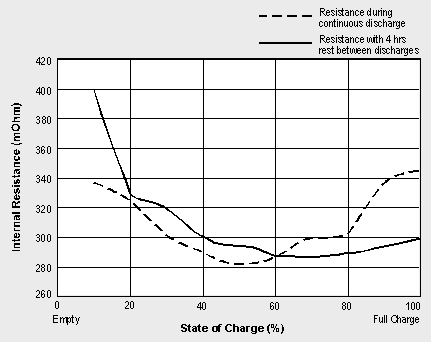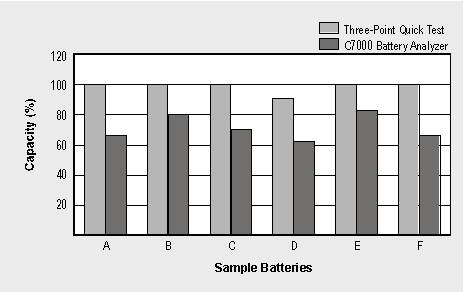<< Previous page INDEX Next page >>
13.2 Three-Point Quick Test
The three-point quick test uses internal battery impedance as a basis and adds the battery voltage under charge and discharge to the equation. The readings are evaluated and compared with reference settings stored in the tester. Let’s explore each of these fundamentals closer to see what it entails:
Internal resistance — To measure the impedance, a battery must be at least 50 percent charged. An empty or nearly empty battery exhibits a high internal resistance. As the battery reaches 50 percent SoH, the resistance drops, then increases again towards full discharge or full charge. Figure 13-1 shows the typical internal resistance curve of a NiMH as a function of charge. Note the decrease of impedance after the battery has rested for a while. To obtain accurate results, allow the battery to rest after discharge and charge.
Figure 13-1: Internal resistance in a NiMH battery.
Note the higher readings immediately after a full discharge and full charge. To obtain accurate results, allow the battery to rest after discharge and charge.Charge Voltage — During charge, the voltage of a battery must follow a narrow predetermined path relating to time. Anomalies such as too high and too low voltages are identified. For example, a fast initial rise reveals that the battery may be fully charged. If the voltage overshoots, the battery may be ‘soft’. This condition often arises when one or more cells have developed dry spots. A frozen battery exhibits a similar effect. If, on the other hand, the voltage does not increase in the allotted time and remains constant, an electrical short is suspected.
Discharge Voltage — When applying a discharge, the voltage drops slightly, and then stabilizes for most of the period in which the energy is drawn. As the battery reaches the end-of-discharge point, the voltage drops rapidly. Observing the initial voltage drop and measuring the voltage delta during the flat part of the discharge curve provides some information as to the SoC. However, each battery type behaves differently and an accurate prediction is not easy. NiCd batteries that have a long flat voltage during most of the discharge period are more difficult to predict using this method than chemistries which exhibit a steady voltage drop under load.
Unfortunately, the battery’s SoC affects the three-point quick test. Even within a charge range of 50 to 90 percent, fluctuations in the test results cannot be avoided. Internal resistance readings further influence the final outcome. If used as a linear correlation with capacity, internal resistance measurements can be highly unreliable, especially with NiCd and NiMH batteries. Figure 13-2 compares the accuracy of six batteries when tested with the three-point quick test. To establish the true capacity, each battery was analyzed by applying a full charge/discharge/charge cycle.
Often referred to as the ‘Feel Good Battery Tester’ because of overly optimistic readings, the three-point quick test method fails to provide the accuracy and repeatability that serious battery users demand.
Figure 13-2: Comparison of battery quick test methods.
Six batteries with different state-of-health conditions were quick tested. The dark gray bars reflect the true state-of-health obtained with the Cadex 7000 Series battery analyzer by applying a full charge/discharge/ charge cycle; the light gray bars are readings derived using the Three-Point Quick Test.The impression of casual battery users that this method is “better than nothing” will not stand up to the requirements of critical industries such as biomedical, law enforcement, emergency response, aviation and defense. Because of relatively low cost, the three-point tester finds a strong niche in the consumer market where a wrong reading is simply a nuisance and does not threaten human safety. Satisfactory readings are achieved in the mobile phone market where batteries are similar in format. It should be noted that the three-point quick test method provides better results than merely measuring the battery’s internal resistance or voltage.

